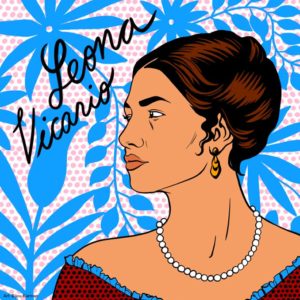Journalist. Protector of insurgents. Rebellion-financer. Los Guadelupes member. Historical icon. Here’s why the herstory of Leona Vicario can’t be forgotten.
In honor of Women’s History Month, we bring you Hidden #Herstories: A series of profiles on remarkable, yet under-celebrated women whose bravery, intelligence, skill, generosity and leadership allowed them to contribute significantly to their respective fields, paving the way for generations of female creators and innovators to come. Presented in partnership with Google Play, these women embody the ethos behind “Change the Game,” an initiative designed to empower women as players and creators in the realm of mobile gaming.
Hidden #Herstories: Leona Vicario — A Key Figure in Mexico’s Battle for Independence
US historians rarely identify or even mention the significant contributions made by colonial women during the American Revolution—typically only going so far as to glorify slave-owning politicians who never bothered to aim a musket. However, our neighbor to the south, Mexico, has honored the women of its revolutions. Leona Vicario’s rebel tale makes her no exception.
As the most prominent female figure in Mexico’s War for Independence waged from 1810-1821,Leona Vicario is regarded as the “Distinguished and Beloved Mother of the Homeland,” a title officially anointed to her by the Mexican Congress of the Union in 1842. In 1910, Leona Vicario and Josefa Ortiz de Dominguez were the first Mexican women to be depicted on Mexican postal stamps. Mexico honored Vicario in 2009 by issuing a five peso coin with her image in anticipation of the bicentennial. But who was she, and why the acclaim?
The beginning
Leona Vicario was baptized as Maria de la Soledad Leona Camila Vicario Fernandez de San Salvador in Mexico City, New Spain. As the daughter of a wealthy Peninsulare (a.k.a Spanish-born) merchant father and a Criollo (Iberian-born in New Spain) mother, Leona had significant social standing in New Spain’s racist caste system that was forcefully imposed on it by the Spanish.
The 16th century Spaniards, along with their overlords in the Roman Catholic Church, were so obsessed with race that they produced posters commissioned by artists to describe the 16 official “racial mixtures” along with their legal statuses. Because of Leona’s parentage, she was publicly acknowledged at the top of the food chain. It made her virtually untouchable when it came to capital crimes, along with a treasure trove of social privileges.
In addition, Leona’s caste status guaranteed her an extensive education. She read and collected Spanish and French literature, studied the fine arts, and enjoyed classical music and singing lessons. European literature at this time was filled with political rhetoric advocating the overthrow of the monarchies. Napoleon was at war in Egypt and the rest of Europe. In North America, Toussaint Louverture had successfully defeated Napoleonic France. Leona developed a rebel spirit.
Leona was 18 when both her parents died in 1807, and by Spanish law, she was assigned to the custody of her maternal uncle and eventual legal guardian Agustin Pomposo Fernandez de San Salvador. He was a Mexico City attorney and a Criollo by birth.
A life of submissive dependency did not interest Leona, however. Leona’s intellectual flowering and interest in radical political views only agitated her maternal uncle, but her extensive education had given her a foundation to develop critical thinking skills, which encouraged independence from her uncle’s patriarchal views, and the perimeters of her social class. Leona refused to be bullied.
She won a court battle to reside in her own property, with her own residential staff in Mexico City. Her uncle countered by buying a property adjacent to hers and arranging for her immediate engagement to Octaviano Obregon, a colonel in the Spanish Army and an attorney working for his firm. Leona cleverly evaded any form of marital commitment to Obregon, but her flirtations with revolutionary idealists soon brought her to the attention of another lawyer, Andres Quintana Roo. The pair eventually married.
READ THE REST OF THE STORY HERE.
Originally published in girlboss 3/20/18.
We are all in this together with you. We want to be a resource for you and for all of the children you love. Whether you need some info or you have info to share, you know where to go…LA Comadre.
Latest posts by La Comadre (see all)
- Cómo está Regresando la Escuela de un Salón - July 28, 2022
- ¿Se Debe Exigir a los Estudiantes recitar el Juramento a la Bandera? - June 10, 2022
- 5 Aplicaciones de Salud Mental y Bienestar para descargar ahora Mismo - May 5, 2022
- How the One Room Schoolhouse Is Making a Comeback - May 5, 2022
- El Dinero Importa: Donación de $ 1 millón a Programas de Educación Financiera en LAUSD - April 25, 2022


